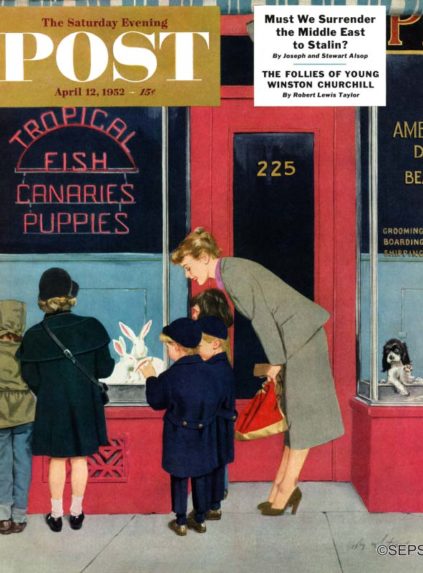Even before graduating from Steele High School in his Midwestern hometown, Dayton, Ohio, Coby Whitmore grew up knowing he wanted to be an artist. Over the course of a professional career spanning more than three decades, his reformations in the illustrative medium changed design concepts forever, earning him an induction into the Society of Illustrators’ Hall of Fame in 1978.
Whitmore began his art education at the Dayton Art Institute, later migrating to an apprenticeship in Chicago. Coby’s experiences in the Midwestern metropolis shaped his redefining style as well as the future of his career. He apprenticed in the studio of Haddon Sandblom[link], worked for the Chicago Herald Examiner, and enrolled in night classes at the Chicago Art Institute. Whitmore’s move to Chicago introduced him to a circle of young artists, most notably his future compatriots, Ben Stahl and Thornton Utz. Together the artistic trio became known as the Chicago Gang.
They did away with excess clutter and lighting, minimizing a model’s surroundings. Whitmore described the evolution of his artistic process as recognition of excess controlling, subjugating, and defining his characters. During a photo shoot in an old heirloom-filled house, he explained, “Then, as I worked along, I discovered that the furniture subordinated the characters. A process of elimination began, and in the finished drawing, all that remains of the beautiful old house is the lamp, the sofa, and a piece of silverware.” The Chicago Gang was partial to illuminating the subtle complexities of human relationships exposed in familiar, if not everyday, circumstances. Whitmore stripped away the overabundance surrounding his models and focused the work on intimate moments between people. Additions were selected with intent. Any objects present either conveyed the illustrator’s message or constructed a comprehensible scene incorporating as few props as possible.
The illustrator eventually headed back east to apprentice again in Ohio, at the studio of Carl Jensen in Cincinnati. He married his high school sweetheart, Virginia Comer, from Dayton and set out for New York City. In 1942, Whitmore joined the prestigious art studio of Charles E. Cooper on West 57th Street.
Much of Whitmore’s work depicts post-war American families, centered around a maternal figure who exudes happiness in the normalcy of everyday life. Coby Whitmore’s popular illustrations were featured on both the covers and in stories of The Saturday Evening Post, McCall’s, Ladies Home Journal, Cosmopolitan, Good Housekeeping, and several corporate advertising campaigns. Accusations of tawdry material (a woman stretching in bed, for example) forced some of his illustrations off magazine covers and into the magazine’s pages. In an interesting twist of fate, Whitmore further advanced his artistic career by combining his sleek lines and minimalist design with his fascination for racing cars. In the early 1950s, he designed the Fitch-Whitmore Le Mans Special with racecar driver John Fitch.
Toward the end of Whitmore’s career, illustration was used less and less. And many artists had to find work illustrating novel covers or headed back to the classroom as teachers. Whitmore eventually retired to Hilton Head, South Carolina. Today, his illustrations are held in both private and permanent collections at institutions such as the Pentagon, the United States Air Force Academy, the New Britain Museum of American Art, and Syracuse University.




